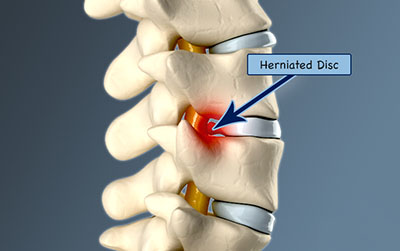 A herniated disc refers to a problem with one of the spinal discs. A herniated disk is also referred to as a slipped disk or ruptured disk.
A herniated disc refers to a problem with one of the spinal discs. A herniated disk is also referred to as a slipped disk or ruptured disk.
A spinal disk is a soft gel-like rubbery cushion that sits in between the spine’s bones. The purpose of these discs is to protect the spine, hold the spine together, and act as shock absorbents. They have a soft, gel-like center with a tough exterior.
A herniated disc can happen in any part of the spine. An injured disc is often more susceptible to irritating a nearby nerve. It often results in radiating pain, numbness, or weakness down the arm or leg, called sciatica.
Symptoms of a Herniated Disk:
Although many people have no symptoms of a herniated disc, some may, such as:
- Radiating numbness or tingling, due to affected nerves.
- Pain in the leg or arm.
- Weakened muscles near the affected nerves.
Causes of a Herniated Disc:
Herniated disks are often difficult to find out what caused it. However, sometimes it can be narrowed down to:
- A sudden movement can cause a herniated disc.
- Due to wear and tear as we age, such as degenerative disc disease, our discs tend to weaken over time. Thus, a herniated disk can occur.
- Herniated disks can run in families.
- Sudden injury. It’s possible to injury your disc if you turn or twist your upper body too quickly.
Non-Surgical Herniated Disc Treatment Options:
Depending on where the herniation occurs, it will also determine treatment. Some can press on nerves in your spine and cause pain and weakness. Sometimes even radiating pain.
However, more commonly the issue will start to improve on its own with a few weeks. Although for proper healing there are precautions you should take, such as:
- Take a few days and relax. Doing so will help relieve swelling and give your body time to heal.
- Medications such as Ibuprofen and Naproxen will help bring down the swelling and inflammation.
- Give physical therapy a try. PT is a great first option before considering surgery. A physical therapist will teach you what exercising promotes healing and pain relief.
- Pain injections are usually also considered, depending on the location. These injections are corticosteroids and are called an epidural injection.
Herniated Disk Surgical Options:
Surgery is the next option if conservative methods are no working. However, if the herniation is severe, surgery may be the only option, such as:
Diskectomy. When the disc requires removal, a discectomy is performed to remove pressure off of the nerves. There are two ways it can be done, such as:
- An incision in the back of the neck.
- Microdiscectomy is done with a tiny camera and a small incision. Allowing for minimal downtime and scarring.
Lumbar laminotomy. The surgeon may need to remove a small piece of bone called the lamina. By removing part of it, the surgeon can then access the herniated disk. Plus, it can also relieve sciatica and leg pain.
Spinal fusion. Following a discectomy or laminectomy, the surgeon may fuse either side of the disc for stability.
Artificial disc replacement. Candidates for this procedure are those who have a herniated disc in the lower back.
Your surgeon will help to determine the correct procedure for your disk problem. For a top spine surgeon in Boca Raton, call us at 888-409-8006.
